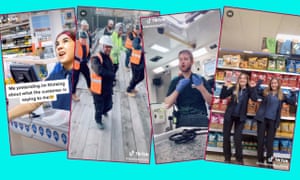
They are some of the most popular videos on the shortform video-sharing app TikTok – clips of uniformed employees, from builders to nurses to supermarket staff, dancing and goofing around in their workplaces.
But police forces and other employers are dissuading staff from posting videos, warning that they risk appearing unprofessional and urging them to not let social media “get in the way of doing their jobs”.
TikTok, the Chinese-owned app that was downloaded more than two million times a day worldwide last year by users mostly aged between 16 and 34, has already propelled homegrown stars such as 15-year-old Charli D’Amelio to household name status as a result of its viral videos. Now a subsection of the app is proving particularly popular among viewers: people dancing on building sites, in shops, or near police stations or hospitals – and it is those workers who are becoming minor TikTok celebrities.
Danny Harris, 35, who works on a building site in central London, first realised he had become famous when he was recognised by staff at a local bakery as being a member of SparksandTarts, a TikTok profile with 34,700 followers.
SparksandTarts’ first video, of five labourers performing a roughly choreographed dance on a city-centre rooftop to a song from the musical Pitch Perfect, has been seen a million times since it was posted a month ago. They’ve now posted 10 videos.
“It has definitely evolved into its own entity,” said Harris. “We’re having TikTok meetings in our breaks to plan what videos we’re going to try to get out there. It’s becoming more of a part-time job. People are messaging each other at the weekend saying: ‘We should try this video next.’”
The popularity of uniformed TikToks has several factors, said Brendan Gahan, chief social officer at marketing agency Mekanism, including the “public embarrassment [which] is definitely fun and cringeworthy.”
The idea that the employees may be discovered skiving off work also attracts audiences, Gahan added. “Generally, the more a piece of content can spark that emotional response, the more it’s shared and sparks a response.”
Harris and his workmates asked for their London building site not to be identified. “We do this in our breaktimes and after tea, and it’s one of these things where all my bosses are happy with it, but, for the sake of the clients funding this build, it’s probably best we’re not advertising exactly where we are,” he said.
That is the fundamental issue many uniformed TikTokers face: while their antics show a different, often more welcoming side to their industry or companies, they run the risk of appearing less than professional.
One Tesco employee, Tyler Beattie, earned 65,000 fans for posting videos of himself dancing in his uniform. In a video posted a few weeks ago, Beattie explained he had been banned from uploading any more videos in uniform. (And he did not respond to many requests for comment.)
A Tesco spokesperson said: “Social media is a fun way to communicate and share information with others. As representatives of Tesco, we ask all our colleagues to use their judgment, respect and common sense online, and make sure that it doesn’t get in the way of doing their jobs.”
However, other Tesco employees continue to post videos from stores in uniform, participating in “challenges” – often carefully choreographed dances to popular songs – that go viral. Nor is it limited to Tesco: videos tagged with the names of the UK’s big four supermarkets have been seen 99 million times on TikTok.
Police officers and paramedics are also going viral on the app. One Cheshire police officer recently passed 10,000 TikTok followers for her insights into how the force operates. Clips of her and colleagues driving the streets to Ridin’ by Chamillionaire, and Sound of da Police by KRS-One have been viewed more than 700,000 times.
The comments to both videos are divided between those who enjoy the lighthearted look into a police officer’s life, and others who think it a distraction from a very serious job.
Peter Caldwell, Cheshire Constabulary’s digital media manager, said: “Social media is one of many channels we use to communicate with the public.” He added that his force has social media guidance it expects staff to follow while at work. “We currently use Twitter, Facebook, YouTube and Instagram to promote the work of the force – however, with the world of digital media constantly evolving, the guidance also applies to new and emerging social media channels.”
For Harris, the popularity of SparksandTarts has come as a surprise. But there is one sure-fire sign they have made the big time on TikTok: a protective and high-vis clothing company has been in touch, asking to send them products they could wear in their videos.
So-called “brand deals” are the holy grail for influencers – and it seems they can even be brokered on building sites.
[“source=theguardian”]
